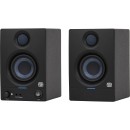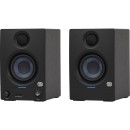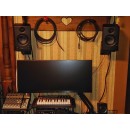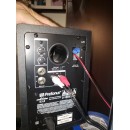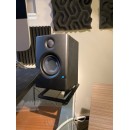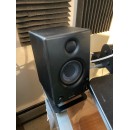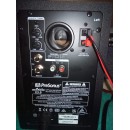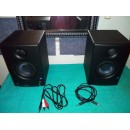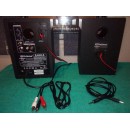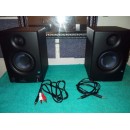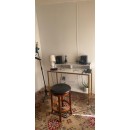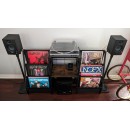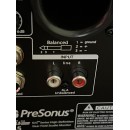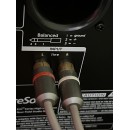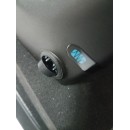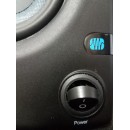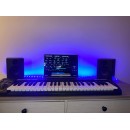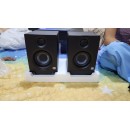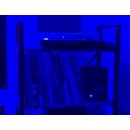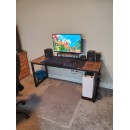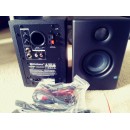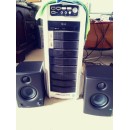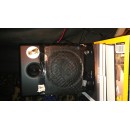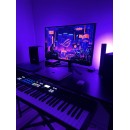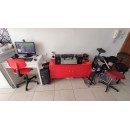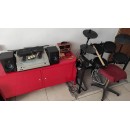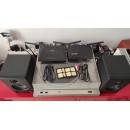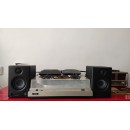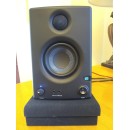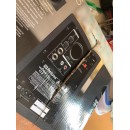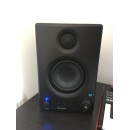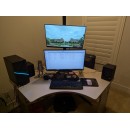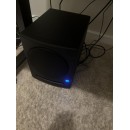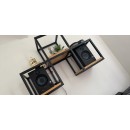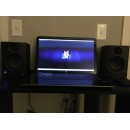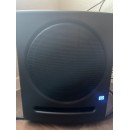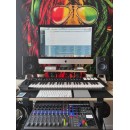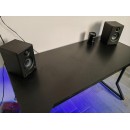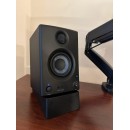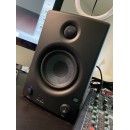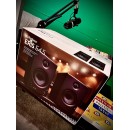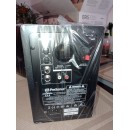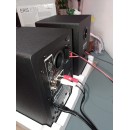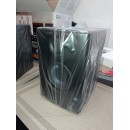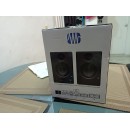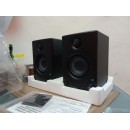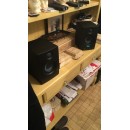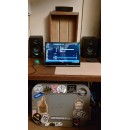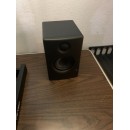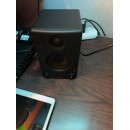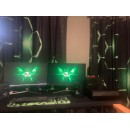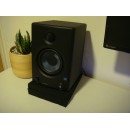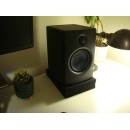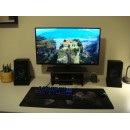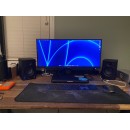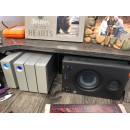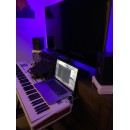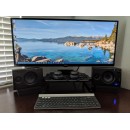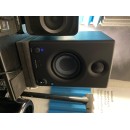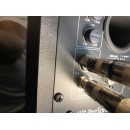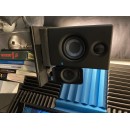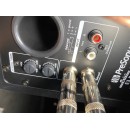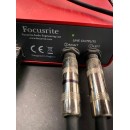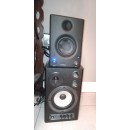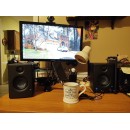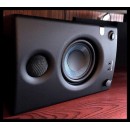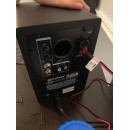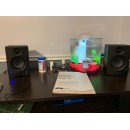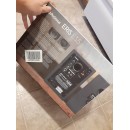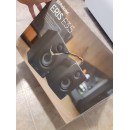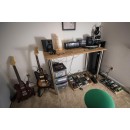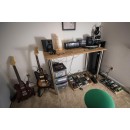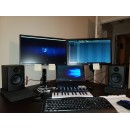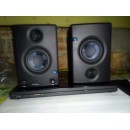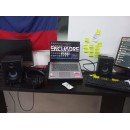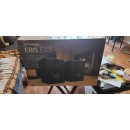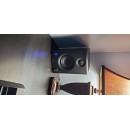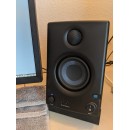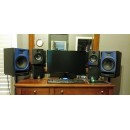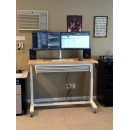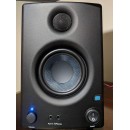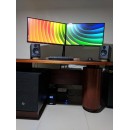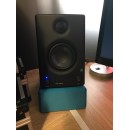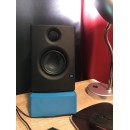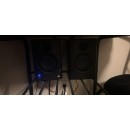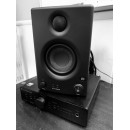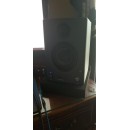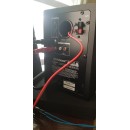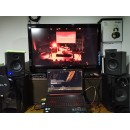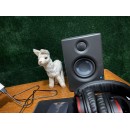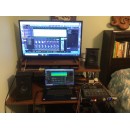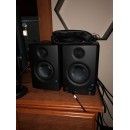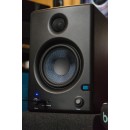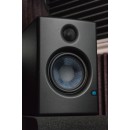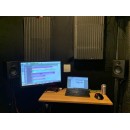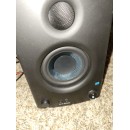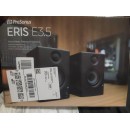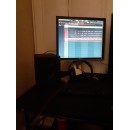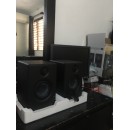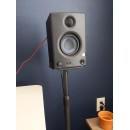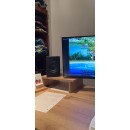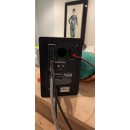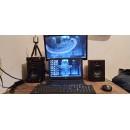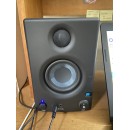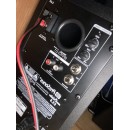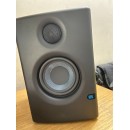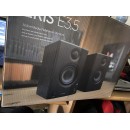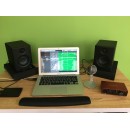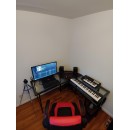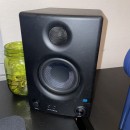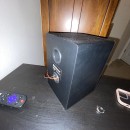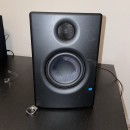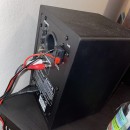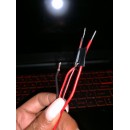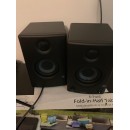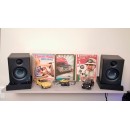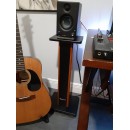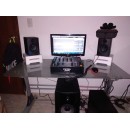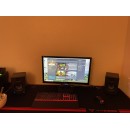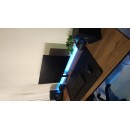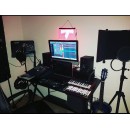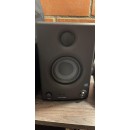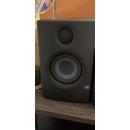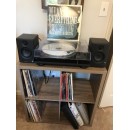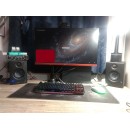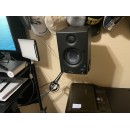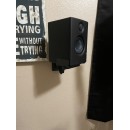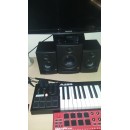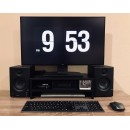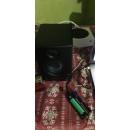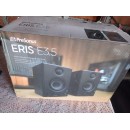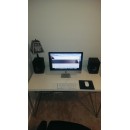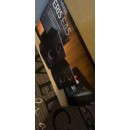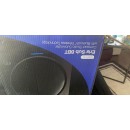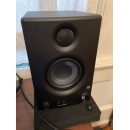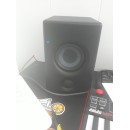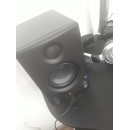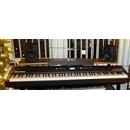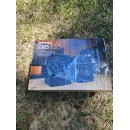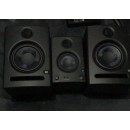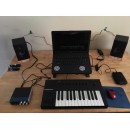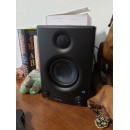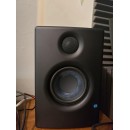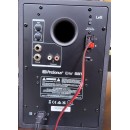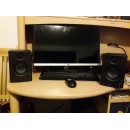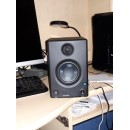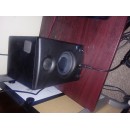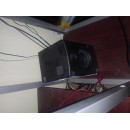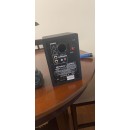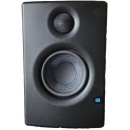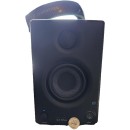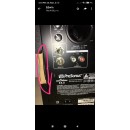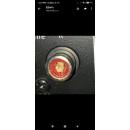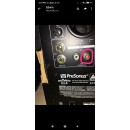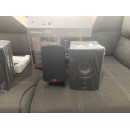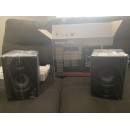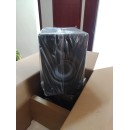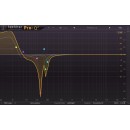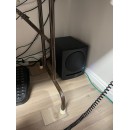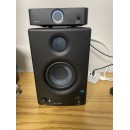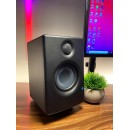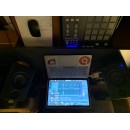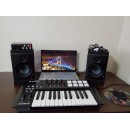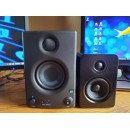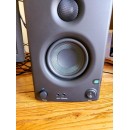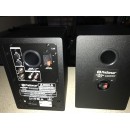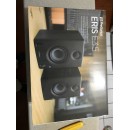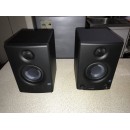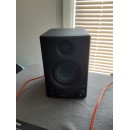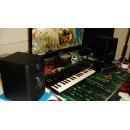PreSonus ERIS 3.5BT vs ERIS 3.5: Studio Monitor Showdown
The PreSonus ERIS 3.5BT Studio Monitor Speaker and the PreSonus ERIS 3.5 Studio Monitor Speaker are both popular choices for those seeking high-quality audio monitoring in a compact form. The primary difference between these two models lies in their connectivity options. The ERIS 3.5BT model comes equipped with Bluetooth functionality, allowing for wireless streaming from compatible devices, which adds a layer of convenience for users who want to connect without the hassle of cables. The standard ERIS 3.5 model, on the other hand, lacks this wireless feature, focusing solely on wired connections for audio input.
Both models share the same core design and specifications when it comes to the audio output. They are equipped with a 3.5-inch Kevlar low-frequency transducer and a 1-inch silk-dome high-frequency transducer, ensuring a balanced and accurate sound. This makes both speakers suitable for a variety of applications, from music production to casual listening. The monitors also include acoustic tuning controls, allowing users to adjust the sound to better fit their environment, which is a feature appreciated by audio professionals.
In terms of inputs, both the ERIS 3.5BT and ERIS 3.5 provide flexibility with TRS, RCA, and Aux inputs, making them compatible with a wide range of audio sources. However, the additional Bluetooth capability in the ERIS 3.5BT offers a level of versatility that might appeal to users who prefer streaming audio directly from their smartphones or tablets. This added functionality makes the ERIS 3.5BT a slightly more versatile option for those who value wireless connectivity, while the standard ERIS 3.5 remains a solid choice for those who prioritize a traditional wired setup.
In this section, we delve into a detailed comparison of the PreSonus ERIS 3.5BT and ERIS 3.5 Studio Monitor Speakers. We will thoroughly examine all their specifications and review their advantages and disadvantages to help you determine which model best suits your audio needs.
In-Depth Comparison of PreSonus ERIS 3.5BT and ERIS 3.5
| User Rating Based on Analysis of Reviews | |
|---|---|
|
Show More |
| Pros: | |
|---|---|
|
|
| Cons: | |
|---|---|
|
|
| Find Best Price | Find Best Price |
| Key Specs | |
|---|---|
| Monitor Type & Configuration | |
| Active 2-Way | Active 2-Way |
| Total Power Output | |
| 25 W RMS per Monitor | 25 W RMS per Monitor |
| Tweeter | |
| 1x 1" / 25.4 mm Silk Dome | 1x 1" / 25.4 mm Silk Dome |
| Woofer | |
| 1x 3.5" / 11.4 cm Cone |
1x 3.5" / 11.4 cm Cone |
| Frequency Range | |
| 80 Hz to 20 kHz | 80 Hz to 20 kHz |
| Audio I/O | |
| 2x 1/4" TRS Balanced Input 1x Stereo 2RCA Unbalanced Input 1x 1/8" / 3.5 mm TRS Unbalanced Input 2x Binding Post Pair Output 1x 1/8" / 3.5 mm TRS Headphone Output |
2x 1/4" TRS Balanced Input 1x Stereo 2RCA Unbalanced Input 1x 1/8" / 3.5 mm TRS Unbalanced Input 2x Binding Post Pair Output 1x 1/8" / 3.5 mm TRS Headphone Output |
| Digital Audio I/O | |
| Network I/O | |
| Wireless | |
| Bluetooth | |
The PreSonus ERIS 3.5BT Studio Monitor Speaker and the PreSonus ERIS 3.5 Studio Monitor Speaker share many common specifications, including their active 2-way monitor type and configuration and a total power output of 25 W RMS per monitor. Both models feature a 1-inch silk dome tweeter and a 3.5-inch cone woofer, contributing to a frequency range of 80 Hz to 20 kHz. This makes them suitable for a variety of audio applications, from music production to general listening.Show More
When it comes to audio I/O options, both speakers offer identical connectivity, featuring 2x 1/4" TRS balanced inputs, 1x stereo 2RCA unbalanced input, 1x 1/8" TRS unbalanced input, 2x binding post pair outputs, and 1x 1/8" TRS headphone output. This ensures versatility for connecting different audio sources. However, the key difference lies in the wired and wireless capabilities; the ERIS 3.5BT model includes Bluetooth functionality for wireless connectivity, while the ERIS 3.5 lacks this feature.
In summary, while both the PreSonus ERIS 3.5BT and PreSonus ERIS 3.5 studio monitor speakers offer similar audio performance and connectivity options, the inclusion of Bluetooth in the ERIS 3.5BT makes it a more versatile choice for users seeking wireless streaming capabilities. For those who prefer a traditional wired connection, the ERIS 3.5 remains a solid option without the added wireless feature.
| General | |
|---|---|
| Number of Included Monitors | |
| Stereo Pair | Stereo Pair |
| Enclosure | |
| Bass-Reflex/Ported | Bass-Reflex/Ported |
| Total Power Output | |
| 25 W RMS per Monitor | 25 W RMS per Monitor |
The PreSonus ERIS 3.5BT Studio Monitor Speaker and the PreSonus ERIS 3.5 Studio Monitor Speaker are both designed as part of the same family of studio monitors, sharing many core features that make them suitable for audio production and playback. Both models come as a stereo pair, providing a balanced sound experience ideal for mixing and monitoring. Their bass-reflex/ported enclosure design enhances low-frequency response, ensuring a rich and dynamic audio output regardless of the listening environment.Show More
In terms of power, both the PreSonus ERIS 3.5BT and the PreSonus ERIS 3.5 deliver a total power output of 25 W RMS per monitor. This output is sufficient for small to medium-sized spaces, allowing for clear sound reproduction without distortion at higher volumes. The similar wattage indicates that both models are equally capable of producing high-quality audio performance, making them suitable for home studios, multimedia applications, and casual listening.
One key difference lies in the connectivity options, as the PreSonus ERIS 3.5BT features Bluetooth connectivity, allowing for wireless streaming from compatible devices. In contrast, the PreSonus ERIS 3.5 does not include Bluetooth, which may appeal to users who prefer a wired connection. Overall, while both models share numerous specifications and benefits, the choice between them may ultimately boil down to the importance of Bluetooth capability for potential users.
| Drivers per Monitor | |
|---|---|
| Tweeter | |
| 1x 1" / 25.4 mm Silk Dome | 1x 1" / 25.4 mm Silk Dome |
| Woofer | |
| 1x 3.5" / 11.4 cm Cone |
1x 3.5" / 11.4 cm Cone |
| Amplifiers | |
| Full-Range: 2 x 25 W RMS Class-AB | Full-Range: 2 x 25 W RMS Class-AB |
The PreSonus ERIS 3.5BT Studio Monitor Speaker and the PreSonus ERIS 3.5 Studio Monitor Speaker share an identical foundation in terms of their technical specifications. Both models feature a 1-inch silk dome tweeter and a 3.5-inch cone woofer, ensuring a balanced sound reproduction that is suitable for various audio applications. This commonality in design indicates that both speakers are engineered to deliver clear high frequencies and a well-defined mid-range, making them suitable for studio monitoring and casual listening alike.Show More
In terms of amplification, the PreSonus ERIS 3.5BT and the PreSonus ERIS 3.5 are equipped with 2 x 25 W RMS Class-AB amplifiers. This means that both models maintain the same power output, providing ample volume for small studio environments or personal listening spaces. The Class-AB amplification contributes to efficient performance, minimizing distortion and ensuring a clean audio signal across various frequency ranges.
The primary differentiation between the two models lies in the Bluetooth capability of the PreSonus ERIS 3.5BT. This feature allows for wireless connectivity, enabling users to stream audio directly from Bluetooth-enabled devices. In contrast, the PreSonus ERIS 3.5 lacks this wireless functionality, making it a more traditional monitor speaker option. While both models excel in sound quality and amplification, the choice between them ultimately depends on whether the user values Bluetooth connectivity for added convenience.
| Performance | |
|---|---|
| Frequency Range | |
| 80 Hz to 20 kHz | 80 Hz to 20 kHz |
| Maximum Sound Pressure Level (SPL) | |
| 97 dB | 97 dB |
| Protections and Limiting | |
| Output Current Limiting | Output Current Limiting |
When comparing the PreSonus ERIS 3.5BT Studio Monitor Speaker and the PreSonus ERIS 3.5 Studio Monitor Speaker, both models exhibit a similar frequency range of 80 Hz to 20 kHz. This ensures that both speakers can reproduce a wide range of audio frequencies, making them suitable for various applications, such as music production, mixing, and casual listening.Show More
In terms of maximum sound pressure level (SPL), both the ERIS 3.5BT and ERIS 3.5 boast a maximum SPL of 97 dB. This level of sound pressure allows for clear and loud sound reproduction, making them effective for studio environments where accurate sound is essential.
Both models also share the same protections and limiting features, including output current limiting. This ensures that the speakers are safeguarded against excessive current that could potentially damage the drivers, thereby enhancing the durability and reliability of both models during extended use.
While both the PreSonus ERIS 3.5BT and ERIS 3.5 share key specifications, it is important to note that the primary distinction lies in the Bluetooth connectivity offered by the ERIS 3.5BT, making it a more versatile option for users seeking wireless audio streaming capabilities. In contrast, the ERIS 3.5 is geared towards users who prefer a traditional wired setup.
| Signal Processing | |
|---|---|
| EQ | |
| 1x HF Shelf 1x LF Shelf |
1x HF Shelf 1x LF Shelf |
| Phase Adjustment | |
When comparing the PreSonus ERIS 3.5BT Studio Monitor Speaker and the PreSonus ERIS 3.5 Studio Monitor Speaker, both models feature similar specifications in terms of equalization capabilities. Each speaker is equipped with a 1x HF Shelf and a 1x LF Shelf, allowing users to tailor the sound to their preferences and the acoustics of their environment. This commonality ensures that both models provide adequate control over high and low frequencies, appealing to users seeking customization in their audio experience.Show More
Another noteworthy aspect of both models is the absence of Phase Adjustment, which is the same for both the PreSonus ERIS 3.5BT and PreSonus ERIS 3.5. This means that neither speaker offers the ability to adjust phase alignment, which could be a consideration for users looking for advanced phase control in their setup. Nonetheless, the lack of this feature does not significantly detract from the overall performance of either model, as they both are still designed for accurate sound reproduction.
In summary, the PreSonus ERIS 3.5BT and PreSonus ERIS 3.5 Studio Monitor Speakers share key features such as equalization options with HF and LF Shelves and the absence of Phase Adjustment. This makes both speakers suitable for those who prioritize sound fidelity and customization without the need for phase correction capabilities.
| Connectivity | |
|---|---|
| Audio I/O | |
| 2x 1/4" TRS Balanced Input 1x Stereo 2RCA Unbalanced Input 1x 1/8" / 3.5 mm TRS Unbalanced Input 2x Binding Post Pair Output 1x 1/8" / 3.5 mm TRS Headphone Output |
2x 1/4" TRS Balanced Input 1x Stereo 2RCA Unbalanced Input 1x 1/8" / 3.5 mm TRS Unbalanced Input 2x Binding Post Pair Output 1x 1/8" / 3.5 mm TRS Headphone Output |
| Digital Audio I/O | |
| Network I/O | |
| USB | |
| Wireless | |
| Bluetooth | |
| Mobile App Compatible | |
The PreSonus ERIS 3.5BT Studio Monitor Speaker and the PreSonus ERIS 3.5 Studio Monitor Speaker share a similar design and feature set, particularly in their audio connectivity options. Both models include 2x 1/4" TRS Balanced Inputs, 1x Stereo 2RCA Unbalanced Input, 1x 1/8" / 3.5 mm TRS Unbalanced Input, 2x Binding Post Pair Outputs, and 1x 1/8" / 3.5 mm TRS Headphone Output. This makes both monitors versatile for connecting various audio sources and headphones, ensuring a good range of compatibility for studio environments.Show More
However, the major distinction between the two models lies in their wireless capabilities. The PreSonus ERIS 3.5BT comes equipped with Bluetooth wireless technology, allowing users to connect their devices without the need for physical cables. In contrast, the PreSonus ERIS 3.5 does not feature any wireless connectivity. This inclusion of Bluetooth in the ERIS 3.5BT offers an added layer of convenience for users who prefer to stream audio directly from their smartphones or tablets.
Both monitors lack additional digital features such as Digital Audio I/O, Network I/O, USB connectivity, and are not Mobile App Compatible. Therefore, when choosing between these two models, the decision largely hinges on the need for wireless functionality. If Bluetooth connectivity is a priority, the PreSonus ERIS 3.5BT would be the preferred choice, while the standard PreSonus ERIS 3.5 remains a solid option for those who do not require this feature.
| Physical | |
|---|---|
| Color | |
| Black | Black |
| Monitor Orientation | |
| Vertical | Vertical |
| Dimensions (W x H x D) | |
| 5.5 x 8.3 x 6" / 139.7 x 210.8 x 152.4 mm (Each) | 5.5 x 8.3 x 6" / 139.7 x 210.8 x 152.4 mm (Each) |
| Weight | |
| 3.1 lb / 1.4 kg (Pair) | 3.1 lb / 1.4 kg (Pair) |
The PreSonus ERIS 3.5BT Studio Monitor Speaker and the PreSonus ERIS 3.5 Studio Monitor Speaker share many similarities in their specifications, including color, monitor orientation, dimensions, and weight. Both models come in a sleek black finish and are designed for vertical orientation, making them suitable for desktop setups and studio environments.Show More
In terms of dimensions, both the ERIS 3.5BT and ERIS 3.5 measure 5.5 x 8.3 x 6 inches (139.7 x 210.8 x 152.4 mm) for each speaker. This compact size allows them to fit comfortably in smaller spaces while still delivering quality sound. Additionally, both models weigh the same, at 3.1 lb (1.4 kg) for the pair, ensuring ease of placement and mobility.
However, the key difference between the two models lies in the Bluetooth connectivity offered by the ERIS 3.5BT. This feature allows for wireless streaming from devices, making it a more versatile option for those who prefer a clutter-free setup. In contrast, the ERIS 3.5 requires a wired connection, which may be preferred by users looking for a more traditional studio monitor experience.
| Packaging Info | |
|---|---|
| Package Weight | |
| 8.88 lb | 8.785 lb |
| Box Dimensions (LxWxH) | |
| 15.9 x 11.3 x 8.8" | 15.4 x 11.5 x 8.9" |
The PreSonus ERIS 3.5BT Studio Monitor Speaker and the PreSonus ERIS 3.5 Studio Monitor Speaker are both compact and lightweight options designed for studio monitoring. The PreSonus ERIS 3.5BT has a package weight of 8.88 lb, while the PreSonus ERIS 3.5 is slightly lighter at 8.785 lb. This minor difference in weight may not significantly impact portability, but it is worth noting for users concerned with carrying equipment.Show More
In terms of dimensions, the PreSonus ERIS 3.5BT measures 15.9 x 11.3 x 8.8 inches, making it a bit larger in length than the PreSonus ERIS 3.5, which has dimensions of 15.4 x 11.5 x 8.9 inches. This slight variation in size may influence how they fit into specific studio setups, but both models maintain a compact profile suitable for small spaces.
Overall, while both models share a similar design ethos and functionality, the PreSonus ERIS 3.5BT offers slightly more weight and length, whereas the PreSonus ERIS 3.5 is marginally lighter and shorter. Users should consider these specifications when choosing the best fit for their studio environment.
| Customer Images | |
|---|---|
| Videos | |
|---|---|
|
|
|
